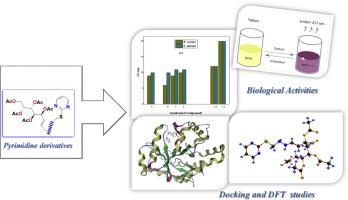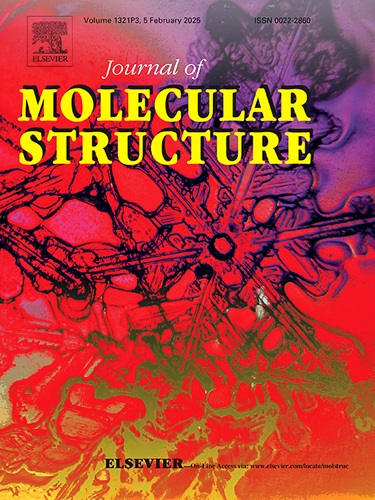New mercaptopyrimidine derivatives synthesized with expected antimicrobial and antioxidant properties and theoretical study
IF 4
2区 化学
Q2 CHEMISTRY, PHYSICAL
引用次数: 0
Abstract
In this elucidation, we synthesized different heterocyclic containing the thiopyrimidine nuclei, through the esterification of 2-mercapto pyrimidine with ethyl chloroacetate to give the corresponding ethyl 2-(pyrimidine-2-ylthio)acetate. Treatment of the ester compound 3 with hydrazine hydrate gave 2-(pyrimidin-2-ylthio)acetohydrazide 4 which acts as the building block for the synthesis of different heterocycles. Firstly the reaction with phenylisothiocyanate to afford the hydrazinecarbothioamide derivative 6 which cyclized in the presence of acidic and basic medium to give ((pyrimidin-2-ylthio)methyl)-1,3,4-thiadiazol-2-amine and triazole derivatives 7,8; respectively. Additionally, the formation of 2-((hydrazinylmethylthio)pyrimidine10 which is reacted with galactose ring to give methyl)hydrazinyl)hept‑6-ene-1,2,3,4,5-pentayl pentaacetate derivative 13 in the presence of acetic acid. All the synthesized compounds were investigated through spectral analysis of 1HNMR, 13CNMR, FT-IR, and mass spectrum. Moreover, the antimicrobial activity of the samples was examined in vitro on both gram-positive and gram-negative bacteria and fungi. Compound 13 displayed a strong efficiency against Bacillus cereus, Staphylococcus aureus, and Pseudomonas aeruginosa, All tested heterocycles exhibited remarkable inhibitory effects against the other pathogenic organisms. Antifungal screening of synthesized heterocycles varied and ranged from no activity to strong activity against Fusarium solani and demonstrated remarkably strong inhibitory activity against Candida albicans. Among all the heterocycles showed high antioxidant activity. These biological results were confirmed through molecular docking analysis utilizing different proteins. Furthermore, the optimization of these compounds was utilized through the DFT/B3LYP/6–311(G) basis set and elucidation of their descriptors and enhanced the biological activities

具有预期抗菌和抗氧化特性的新巯基嘧啶衍生物的合成及理论研究
在这项研究中,我们通过 2-巯基嘧啶与氯乙酸乙酯的酯化反应,得到相应的 2-(嘧啶-2-基硫基)乙酸乙酯,从而合成了含有噻吩嘧啶核的不同杂环。用肼水合物处理酯化合物 3 后,得到 2-(嘧啶-2-基硫基)乙酰肼 4,它是合成不同杂环的基本成分。首先与苯基异硫氰酸酯反应,得到硫代肼酰胺衍生物 6,该衍生物在酸性和碱性介质存在下发生环化,分别得到((嘧啶-2-基硫基)甲基)-1,3,4-噻二唑-2-胺和三唑衍生物 7、8。此外,在乙酸存在下,2-((肼基甲硫基)嘧啶10 与半乳糖环反应生成甲基)肼基)庚-6-烯-1,2,3,4,5-五乙酸酯衍生物 13。所有合成化合物均通过 1HNMR、13CNMR、FT-IR 和质谱等光谱分析进行了研究。此外,还在体外检测了样品对革兰氏阳性和阴性细菌及真菌的抗菌活性。化合物 13 对蜡样芽孢杆菌、金黄色葡萄球菌和铜绿假单胞菌有很强的抑制作用。合成的杂环化合物的抗真菌筛选结果各不相同,对禾谷镰刀菌的活性从无到有,对白色念珠菌的抑制活性也非常强。所有杂环化合物都显示出很高的抗氧化活性。利用不同蛋白质进行的分子对接分析证实了这些生物学结果。此外,还通过 DFT/B3LYP/6-311(G) 基集对这些化合物进行了优化,并阐明了其描述因子,从而提高了其生物活性。
本文章由计算机程序翻译,如有差异,请以英文原文为准。
求助全文
约1分钟内获得全文
求助全文
来源期刊

Journal of Molecular Structure
化学-物理化学
CiteScore
7.10
自引率
15.80%
发文量
2384
审稿时长
45 days
期刊介绍:
The Journal of Molecular Structure is dedicated to the publication of full-length articles and review papers, providing important new structural information on all types of chemical species including:
• Stable and unstable molecules in all types of environments (vapour, molecular beam, liquid, solution, liquid crystal, solid state, matrix-isolated, surface-absorbed etc.)
• Chemical intermediates
• Molecules in excited states
• Biological molecules
• Polymers.
The methods used may include any combination of spectroscopic and non-spectroscopic techniques, for example:
• Infrared spectroscopy (mid, far, near)
• Raman spectroscopy and non-linear Raman methods (CARS, etc.)
• Electronic absorption spectroscopy
• Optical rotatory dispersion and circular dichroism
• Fluorescence and phosphorescence techniques
• Electron spectroscopies (PES, XPS), EXAFS, etc.
• Microwave spectroscopy
• Electron diffraction
• NMR and ESR spectroscopies
• Mössbauer spectroscopy
• X-ray crystallography
• Charge Density Analyses
• Computational Studies (supplementing experimental methods)
We encourage publications combining theoretical and experimental approaches. The structural insights gained by the studies should be correlated with the properties, activity and/ or reactivity of the molecule under investigation and the relevance of this molecule and its implications should be discussed.
 求助内容:
求助内容: 应助结果提醒方式:
应助结果提醒方式:


